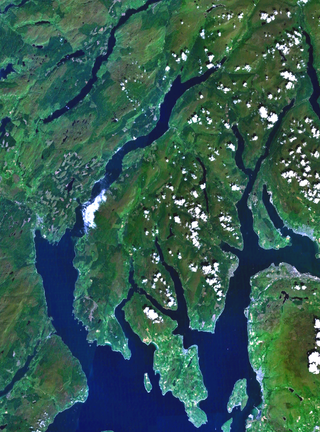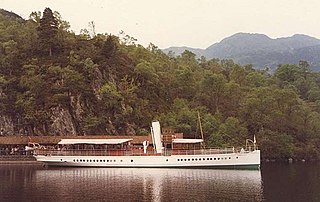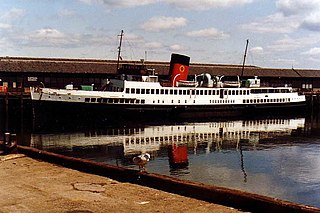
Argyll and Bute is one of 32 unitary council areas in Scotland and a lieutenancy area. The current lord-lieutenant for Argyll and Bute is Jane Margaret MacLeod. The administrative centre for the council area is in Lochgilphead at Kilmory Castle, a 19th-century Gothic Revival building and estate. The current council leader is Councillor Jim Lynch.

The Firth of Clyde, is the estuary of the River Clyde, on the west coast of Scotland. The Firth has some of the deepest coastal waters of the British Isles. The Firth is sheltered from the Atlantic Ocean by the Kintyre Peninsula. The Firth lies between West Dunbartonshire in the north, Argyll and Bute in the west and Inverclyde, North Ayrshire and South Ayrshire in the east. The Kilbrannan Sound is a large arm of the Firth, separating the Kintyre Peninsula from the Isle of Arran. The Kyles of Bute separates the Isle of Bute from the Cowal Peninsula. The Sound of Bute separates the islands of Bute and Arran.

Gourock is a town in the Inverclyde council area and formerly a burgh of the County of Renfrew in the west of Scotland. It was a seaside resort on the East shore of the upper Firth of Clyde. Its main function today is as a residential area, extending contiguously from Greenock, with a railway terminus and ferry services across the Clyde.

Caledonian MacBrayne, in short form CalMac, is the trade name of CalMac Ferries Ltd, the major operator of passenger and vehicle ferries to the west coast of Scotland, serving ports on the mainland and 22 of the major islands. It is a subsidiary of holding company David MacBrayne, which is owned by the Scottish Government.

Cowal is a rugged peninsula in Argyll and Bute, on the west coast of Scotland. It is connected to the mainland to the north, and is bounded by Loch Fyne to the west, by Loch Long and the Firth of Clyde to the east, and by the Kyles of Bute to the south.

Loch Long is a body of water in the council area of Argyll and Bute, Scotland. The Sea Loch extends from the Firth of Clyde at its southwestern end. It measures approximately 20 miles in length, with a width of between one and two miles. The loch also has an arm, Loch Goil, on its western side.

SS Sir Walter Scott is a small steamship that has provided pleasure cruises and a ferry service on Loch Katrine in the scenic Trossachs of Scotland for more than a century, and is the only surviving screw steamer in regular passenger service in Scotland. She is named after the writer Walter Scott, who set his 1810 poem Lady of the Lake, and his 1818 novel Rob Roy around Loch Katrine.

TS Queen Mary is a Clyde steamer launched in 1933 at the William Denny shipyard, Dumbarton, for Williamson-Buchanan Steamers. She is currently being restored as a museum ship, in Glasgow.

PS Maid of the Loch is the last paddle steamer built in the United Kingdom. She operated on Loch Lomond for 29 years. As of 2022, she was being restored near Balloch pier.

The Clyde steamer is the collective term for several passenger services that existed on the River Clyde in Scotland, running from Glasgow downstream to Rothesay and other towns, a journey known as going doon the watter.

MV The Second Snark is a small passenger ferry, built in 1938 by William Denny of Dumbarton, later operated by Clyde Marine Services on the Firth of Clyde, Scotland.

Gourock railway station is a terminus of the Inverclyde Line, located at Gourock pierhead, Scotland. It was originally closely integrated with an extensive clyde steamer pier as well as serving the coastal resort town. The ferry services terminal is now located at the east end of platform 1, with provision for vehicle ferries.

William Denny and Brothers Limited, often referred to simply as Denny, was a Scottish shipbuilding company.

The Caledonian Steam Packet Company provided a scheduled shipping service, carrying freight and passengers, on the west coast of Scotland. Formed in 1889 to complement the services of the Caledonian Railway, the company expanded by taking over rival ferry companies. In 1973, they were merged with MacBraynes as Caledonian MacBrayne.
The Caledonian and Dumbartonshire Junction Railway (C&DJR) was a Scottish railway opened in 1850 between Bowling and Balloch via Dumbarton. The company had intended to build to Glasgow but it could not raise the money.

MV Arran was a pioneering Firth of Clyde vehicle ferry introduced by Caledonian Steam Packet Company in 1953. She spent fifteen years on the Upper Clyde crossings, followed by five years at Islay. Initially hoist-loading, via side ramps, these were replaced by a stern ramp in 1973. During her final years with CalMac, she relieved across the network. Several unsuccessful attempts were made to turn her into a floating restaurant, before she was scrapped in 1993.

PS Caledonia was a paddle steamer built in 1934. She principally provided an Upper Clyde ferry service, later moving to Ayr and then Craigendoran.

TS Duchess of Montrose was a Clyde passenger steamer, built in 1930 for the Caledonian Steam Packet Company. She was a popular boat, providing day cruises until 1964.
The Inverarnan Canal was a short length of canal terminating at Garbal, close to the hamlet of Inverarnan, Scotland. This waterway once linked the old coaching inn, now the Drovers Inn, at Inverarnan, on the Allt Arnan Burn to the River Falloch and passengers could continue southward to Loch Lomond and finally to Balloch. From Inverarnan stagecoaches ran to various destinations in the north of Scotland.

The Loch Tay Steamboat Company operated steamer services on Loch Tay Scotland from 1882 to 1921.


















